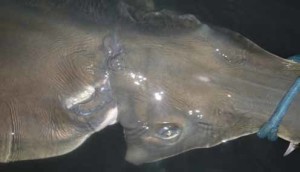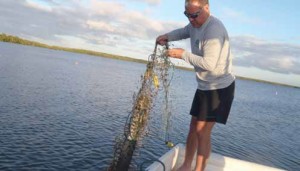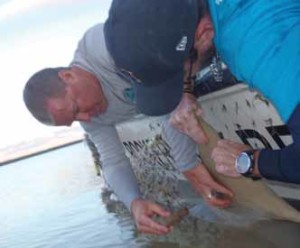Nets a 15-Foot Sawfish in 10,000 islands

Evidence of a previous encounter with 3mm thick monofilament line is clearly seen behind the sawfish’s eye
Many species of shark come into shallow, protected estuarine bays to give birth to their young. These back bays provide young sharks with plenty of food and protection from potential predators, such as larger sharks. To gain an understanding of shark nurseries and relative distributions before, during and after the restoration of the Ten Thousand Islands watershed, a monthly monitoring and tagging program was established in Rookery Bay National Estuarine Research Reserve in May 2000.
Since that time, the data has confirmed another important fact: Southwest Florida estuaries are important nursery habitats for the endangered Smalltooth sawfish (Pristis pectinata).
Smalltooth sawfish are fishes closely related to sharks and rays with skeletons composed of cartilage. Their distinctive rostrum has about 30 teeth on both sides and is used for defense and hunting prey. Southwest Florida estuaries have the greatest concentration of Smalltooth sawfish in the world.
While monitoring the local shark population over the past 14 years, Rookery Bay fisheries research has captured 36 different sawfish, ten of which being recaptured at least once.

Rookery Bay Reserve fisheries biologist Pat O’Donnell plans a strategy for extracting the sawfish from his gillnet
In 2002 and 2003, 11 juvenile sawfish were captured, measured, tagged and released. Four of those individuals were recaptures. The growth data obtained from these recaptures contributed to a scientific journal paper that suggested these fish exhibit substantially faster growth rates than previous literature Rookery Bay Reserve Fisheries Biologist in Ten Thousand Islands Nets 15-foot Saw fish rookery bay has reported. Within the last two years (Feb 2012 – Mar 2014), 17 juvenile and one sub-adult female sawfish were captured, tagged and released. All of these tagged sawfish, except the one large female, were 8 feet or less and assumed to be one to two years old.
On March 7, 2014 Rookery Bay Reserve fisheries biologist Pat O’Donnell captured three Smalltooth sawfish in Fakahatchee Bay. The first of the evening was a female measuring nearly 15 feet and is the largest sawfish captured in this study to date. She had some 3mm thick monofilament fishing line wrapped around her head
causing deformation near the right eye and right spiracle (organ used in water exchange).
Once secured to the side of the boat she was measured and tagged, and a fin clip sample was taken for genetic analysis prior to her safe release. The other two sawfish caught that night both measured around 8 feet. One of those had been tagged previously by the National Marine Fisheries Service near Pavillion Key in Everglades National Park 17 months prior.
Sawfish can be extremely dangerous. Anyone who encounters one must be extremely careful of the toothed rostrum (nose) which can slash through human skin with ease. Because they are protected by federal law, if you happen to catch a sawfish while fishing, it is very important to ensure the minimum amount of fishing tackle remains with the sawfish following release.
Rookery Bay National Estuarine Research Reserve encompasses 110,000 acres of coastal lands and waters between Naples and Everglades National Park. It is managed by the Florida Department of Environmental Protection’s Coastal Office in cooperation with NOAA.
For more information visit www.rookerybay.org.


Leave a Reply
Want to join the discussion?Feel free to contribute!